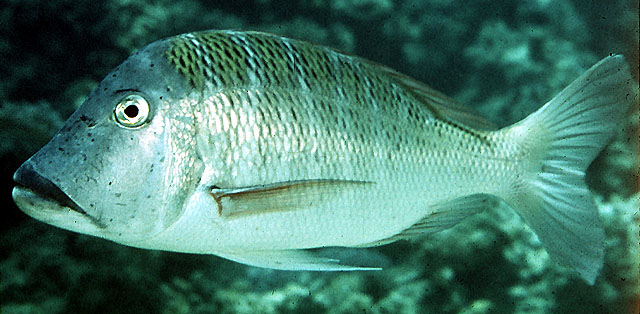| Lethrinidae (Emperors or scavengers), subfamily: Lethrininae |
| 65 cm TL (male/unsexed); max. reported age: 27 years |
|
reef-associated; marine; depth range 2 - 100 m, non-migratory |
| Indian Ocean: Red Sea and East Africa to Sri Lanka. References to this species from the Central Pacific probably refer to Lethrinus atkinsoni. |
|
Dorsal spines (total): 10-10; Dorsal soft rays (total): 9-9; Anal spines: 3-3; Anal soft rays: 8-8. Body color is yellow to greenish-blue, becoming lighter ventrally; usually with nine or ten dusky yellow-green or brown bars. The head is purplish gray, sometimes with a red blotch on the nape. A red bar is at the base of pectoral fin, sometimes extending broadly below and above the pectoral fin base to the edge of the operculum. The base of the upper and sometimes lower rays of pectoral fin is red. The base and tips of the pelvic fins are often red. The membranes of the dorsal fin is red (sometimes restricted to the base of the fins). The anal fin is whitish with the membranes between the forward rays often red. The caudal fin, especially the tips is reddish. |
| Found over reef areas and adjacent sandy and seagrass areas (Ref. 30573, 41878). Feeds mainly on echinoderms (most frequently sea urchins), crustaceans and fishes; mollusks, tunicates, sponges, polychaetes and other worms are consumed in lesser quantities. A protogynous hermaphrodite (Ref. 55367). In most areas of the Red Sea, it is considered an excellent food fish but in certain areas of the Indian Ocean it may have an unpleasant 'coral' smell and taste (Ref. 2295, 11888). Utilized fresh for broiling and baking (Ref. 9987). |
|
Endangered (EN); Date assessed: 28 June 2018 (A2bd) Ref. (130435)
|
| harmless |
Source and more info: www.fishbase.org. For personal, classroom, and other internal use only. Not for publication.
